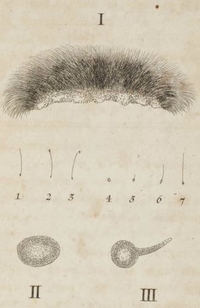|

Vegetative reproduction of conferva fontinalis. Click to enlarge. Engraving accompanying “IV. Prof. Blumenbach über eine ungemein einfache Fortpflanzungsart”, in Göttingisches Magazin der Wissenschaften und Litteratur, 2. Jg., 1. Stück (1781), pp. 80–89 (bibliography nr. 0800). This type of algae was called “Brunnen-Conferve” by Blumenbach and served as “proto-model organism” for his research on the “formative drive”, cf. Feigenbaum, Ryan: “Blumenbach and the Conferva fontinalis. A talk delivered at the New York Botanical Garden on November 15, 2015.”; online version. |
|
| Johann Friedrich Blumenbach’s significance for a number of subjects and intellectual currents is nowhere more evident than in his concept of the “Bildungstrieb” (formative drive). It was decisive both for the life sciences and for the idea of education in the humanities and arts. Indeed, the Humboldt brothers – Blumenbach’s students – or also Goethe still shape our idea of education today. The conference is the first attempt to take a systematic look at the scattered research on Blumenbach’s concept of the “formative drive” and the long history of its impact (research literature on this topic). We will examine the genesis, reception and later appropriations of his conception of life science, as well as the socio-political context of the debates triggered by it (contemporary reviews of Blumenbach’s publications on the “Bildungstrieb”). Moreover, for the natural history collections of the “Academisches Museum” in Göttingen, Blumenbach acquired numerous objects from all over the world as empirical evidence for his research. Our attention will therefore also be directed to the material culture of the natural sciences. |
| There were four sessions: |
| Session 1: The naturalistic turn and the concept of self-organisation 1750–1850 Blumenbach’s naturalization of the concept of nature was preceded by a long process of reinterpretation of the concept of nature and man. Gottfried Wilhelm Leibniz and his school – Albrecht von Haller, Georges-Louis Leclerc de Buffon and Immanuel Kant, to mention only the most important names – had continued to change the concept of nature by working towards a physiological understanding of nature based on Samuel Pufendorf and the ancient views of Pliny and Lucretius. No less important than metaphysics and natural history is the development of theology, especially in Göttingen, where theologians/orientalists such as Johann David Michaelis and Johann Gottfried Eichhorn desacralized the biblical conception of nature by means of higher criticism. Linked to secularization are the developing conception of the self-organization of nature and the theory of the progressive autogenesis of species. The conference takes up this more recent discussion from the field of the history of science and links it with Blumenbach’s conception of a “Bildungstrieb”.
|
| Session 2: Blumenbach’s Bildungstrieb and the question of epigenesis Blumenbach’s conception of the “formative drive” is closely linked to the observations he made on his collection objects. In this section, based on the edition of Blumenbach’s works and collections, his working methods will be examined in greater detail, as will his commitment to the establishment of the “Academisches Museum” in Göttingen. Whereas it is clear that Blumenbach’s theory of a “formative drive” would have been inconceivable without the collection objects, it is still unclear how collection and the development of Blumenbach’s anthropological and other natural history theories are connected. Similar and contrasting views on generation and regeneration, such as those of Immanuel Kant or Johann Christian Reil, are the subject of this section, in order to define more precisely the characteristics of Blumenbach’s theory.
|
| Session 3: Blumenbach’s Bildungstrieb and the wider notion of Bildung The transfer of Blumenbach’s views on natural history to other fields, especially those of human education, had a far-reaching impact on the arts and the politics of education. Through his students and correspondence, Blumenbach’s theory of “Bildung” had an influence on Weimar Classicism, the Romantic movement and idealistic philosophy. Goethe’s conception of nature and his conception of world literature, for example, or Wilhelm von Humboldt’s ideas of human education have had – not least benefiting from the impact of the French Revolution – a long-lasting aftereffect, which has so far only been examined sporadically.
|
Session 4: “What is Life?” – then and nowThe fourth and last section addresses Blumenbach’s topicality today. The first Blumenbach-online conference, in 2015, demonstrated the ongoing, present-day significance of Blumenbach in debates about (anti)racism; the current conference, in this section, deals with the validity of Blumenbach’s views on the emergence of life, generation and regeneration in the context of today’s science. Together with the interdisciplinary working group “Origin of Life” of the Göttingen Academy of Sciences – and remembering Erwin Schrödinger’s magisterial book What is Life. The Physical Aspect of the Living Cell (1944) – this section discusses the longue durée of Blumenbach’s view of natural life and its development.
|
| As part of the conference, Prof. Dietrich v. Engelhardt gave a public evening lecture on “»Bildung« in Natur und Kultur um 1800” in the Aula am Wilhelmsplatz on 14 October 2021 at 6 pm: |
| Johann Friedrich Blumenbach coined the term “Bildungstrieb” in 1780. The term originally belonged to the context of the question of the nature of life and the cause of the emergence of organized, living structures from inanimate matter. Blumenbach’s scientific concept of “Bildung” was taken up and further developed in the philosophy, arts, history and jurisprudence of idealism and romanticism. This fascinating dialogue around 1800 between the four cultures of natural sciences, humanities, arts and life, whose separation seems insurmountable today, is the theme of Dietrich v. Engelhardt’s lecture.
The medical and science historian Prof. Dr. Dietrich v. Engelhardt taught at the universities of Heidelberg, Lübeck and Munich. He is internationally recognized as a leading expert on German Romanticism. v. Engelhardt is member of the German National Academy of Science Leopoldina and was recently honoured with the Alexander von Humboldt medal of the Society of German Natural Scientists and Physicians.
|
|
|

